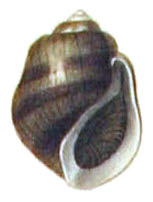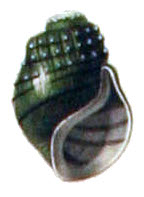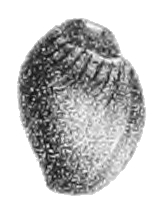Plicate rocksnail facts for kids
Quick facts for kids Plicate rocksnail |
|
|---|---|
 |
|
| 1842 drawing of the shell of Leptoxis plicata by Jean-Charles Chenu. | |
| Conservation status | |
| Scientific classification | |
| Kingdom: | |
| Phylum: | |
| Class: | |
| (unranked): |
clade Caenogastropoda
clade Sorbeoconcha |
| Superfamily: |
Cerithioidea
|
| Family: |
Pleuroceridae
|
| Genus: |
Leptoxis
|
| Species: |
L. plicata
|
| Binomial name | |
| Leptoxis plicata Conrad, 1834
|
|
| Synonyms | |
|
Anculotus plicatus Conrad, 1834 Anculotus plicata Conrad |
|
The plicate rocksnail, known scientifically as Leptoxis plicata, is a type of freshwater snail. It has a special body part called a gill for breathing underwater and an operculum, which is like a trapdoor that closes its shell. This snail is an aquatic gastropod (a type of mollusk) and belongs to the family Pleuroceridae.
This snail is found only in the United States, specifically in the state of Alabama. The plicate rocksnail has been listed as an endangered species since October 28, 1998. This means it is at a very high risk of disappearing forever.
Contents
What Does the Plicate Rocksnail Look Like?
The plicate rocksnail is a kind of snail from the Pleuroceridae family. Its shell can grow to about 20 millimeters (0.8 inches) long. The shells are somewhat round, like a globe, with wide openings called apertures.
The main part of the shell, called the body whorl, might have strong folds or ridges. These folds are known as plicae. The shell is usually brown, but sometimes it can be green. Often, it has four evenly spaced color bands. The central part of the shell, the columella, is smooth and rounded. It is usually colored in its upper half. The opening of the shell is typically bluish-white, but can also be pink or white.
The operculum is a plate that closes the shell when the snail pulls itself inside. For the plicate rocksnail, this operculum is dark red and quite thick. Even though it looks similar to other rocksnail species in its area, the plicate rocksnail is unique in its genetics.
Where Do Plicate Rocksnails Live?
Historically, the plicate rocksnail lived in the Black Warrior River, the Little Warrior River, and the Tombigbee River. These rivers are all in Alabama.
However, recent studies show that plicate rocksnails are now found in a much smaller area. They are only in about 88 kilometers (55 miles) of the Locust Fork of the Black Warrior River. This area is in Jefferson and Blount counties, Alabama. The most recent information suggests that the snail has disappeared from most of this habitat. It now seems to be limited to only about 32 kilometers (20 miles) in Jefferson County.
Why Are Plicate Rocksnails Disappearing?
The plicate rocksnail has disappeared from more than 90 percent of the places it used to live. The main reason for this big decline is the building of dams. Dams have greatly reduced the snail's habitat in the larger rivers of the Mobile Basin. These rivers include the Black Warrior River, the Little Warrior River, and the Tombigbee River.
When dams are built, they create large, still bodies of water called reservoirs. These reservoirs flood the snail's natural shoal habitats. Shoals are shallow, rocky areas in rivers where the water flows quickly. The plicate rocksnail has disappeared from all parts of its historic home that have been flooded by dams.
Dams change river areas in several ways:
- They stop or slow down the natural water currents.
- This allows dirt and sand (sediments) to build up on the river bottom.
- The water chemistry also changes in these still waters. For example, many reservoirs can become eutrophic. This means they have too many nutrients, which can lead to low oxygen levels.
These physical and chemical changes make it hard for the snails to find food, breathe, and reproduce.
Plicate Rocksnail Habitat and Life Cycle
Habitat
Plicate rocksnails live in shallow areas of rivers where the water flows. They prefer places with gravel and small rocks (cobble shoals).
Life Cycle
Scientists don't know exactly how long plicate rocksnails live in the wild. However, some individuals have lived for 2 years when kept in special care.
See also
 In Spanish: Leptoxis plicata para niños
In Spanish: Leptoxis plicata para niños




